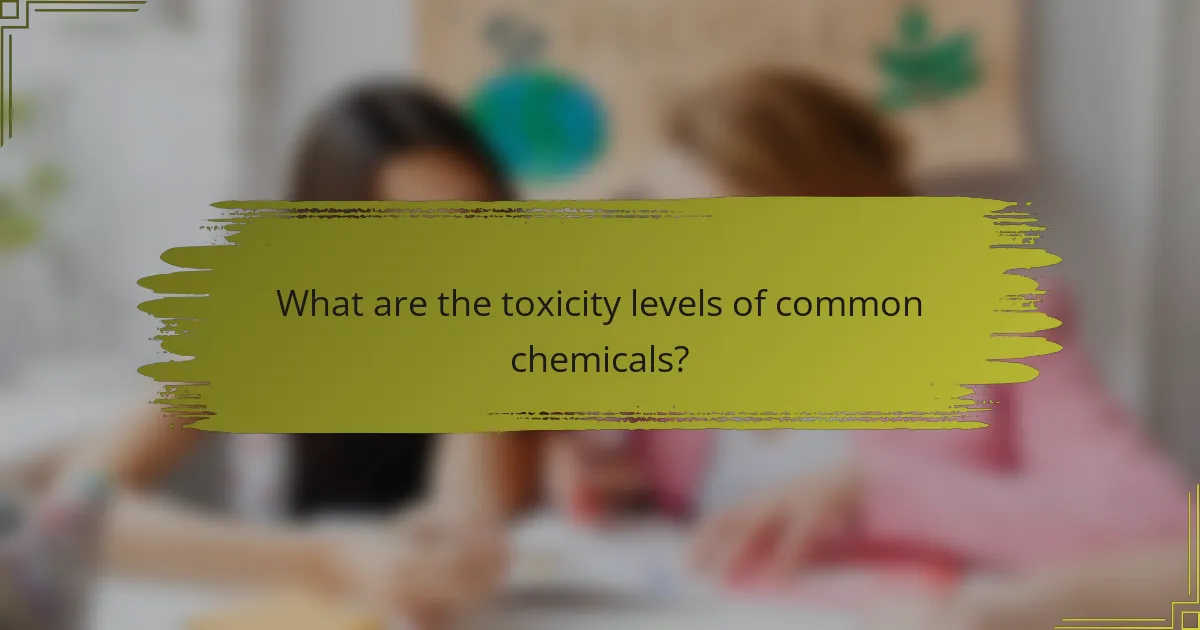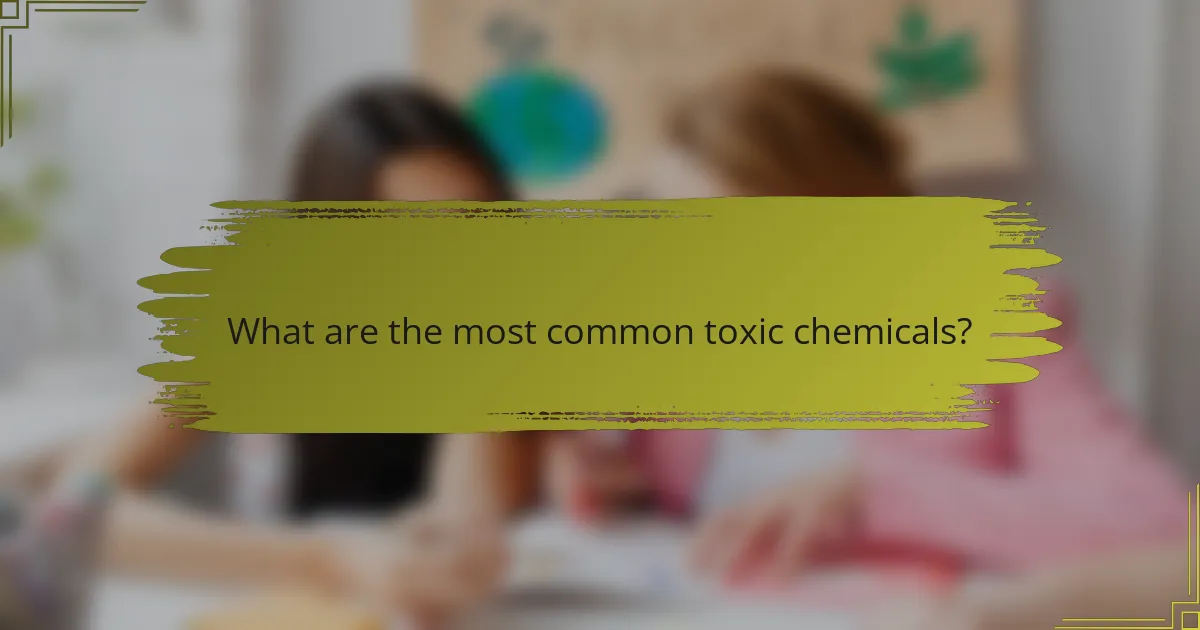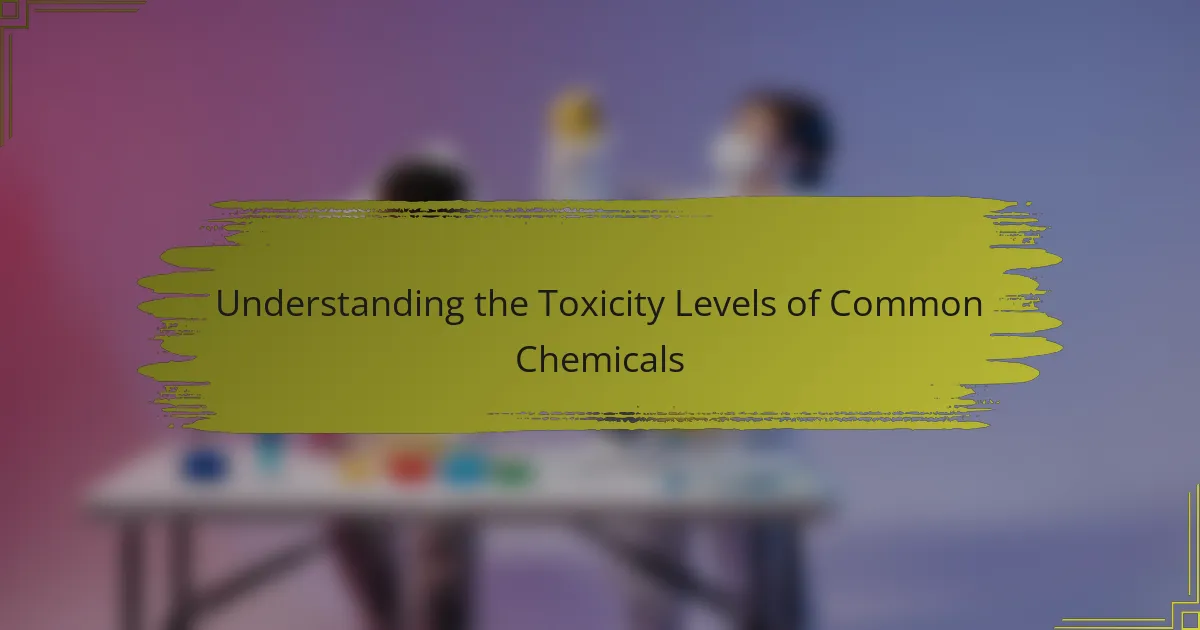
What are the toxicity levels of common chemicals?
Toxicity levels of common chemicals vary significantly. For example, sodium chloride has a low toxicity level with an LD50 of about 3,000 mg/kg in rats. In contrast, cyanide is highly toxic, with an LD50 of approximately 1 mg/kg. Methanol has an LD50 of around 5,000 mg/kg, indicating moderate toxicity. Acetaminophen shows a toxic dose at about 200 mg/kg, leading to liver damage. Ammonia is also toxic, with an LD50 of 350 mg/kg. These values illustrate the range of toxicity levels among common chemicals. Understanding these levels helps in assessing risks associated with chemical exposure.
How is chemical toxicity measured?
Chemical toxicity is measured using various methods, including dose-response assessments and toxicity tests. Dose-response assessments determine the relationship between the amount of a chemical and its effect on organisms. Toxicity tests often involve exposing organisms to different concentrations of a chemical to observe adverse effects. Common organisms used in these tests include fish, invertebrates, and bacteria.
The results are typically expressed as lethal concentration (LC50) or effective concentration (EC50). LC50 indicates the concentration required to kill 50% of test subjects within a specified time. EC50 represents the concentration that produces a specified effect in 50% of subjects.
These measurements help establish safety thresholds for chemicals. Regulatory agencies, like the Environmental Protection Agency (EPA), use these data to set exposure limits. Toxicity measurements are essential for assessing risks to human health and the environment.
What scales are used to classify toxicity levels?
The scales used to classify toxicity levels include the LD50, LC50, and NOAEL. LD50 stands for lethal dose for 50% of a test population. It quantifies the amount of a substance required to kill half of the test subjects. LC50, or lethal concentration for 50%, measures the concentration of a substance in air or water that causes death in 50% of test subjects. NOAEL refers to the No Observed Adverse Effect Level, indicating the highest dose at which no harmful effects are observed. These scales are essential in toxicology for assessing the safety of chemicals. They provide a standardized method for comparing the toxicity of different substances.
What factors influence toxicity measurements?
Toxicity measurements are influenced by several key factors. These include the chemical structure of the substance, which affects its reactivity and interaction with biological systems. The dose or concentration of the substance is crucial, as higher doses typically lead to increased toxicity. Exposure duration also plays a significant role; longer exposure times can enhance toxic effects.
Environmental conditions, such as temperature and pH, can alter the toxicity of a chemical. The presence of other substances can lead to synergistic or antagonistic effects, impacting overall toxicity. Individual susceptibility, including genetic factors and pre-existing health conditions, can modify how organisms respond to toxins.
Research indicates that these factors are critical in assessing the risk associated with chemical exposure. For example, the National Research Council highlights that understanding these variables is essential for accurate toxicity assessment.
Why is understanding chemical toxicity important?
Understanding chemical toxicity is important for ensuring public health and safety. Toxicity refers to the degree to which a substance can harm humans or the environment. Knowledge of chemical toxicity helps in risk assessment and management. It informs regulatory guidelines for safe exposure levels. For instance, the U.S. Environmental Protection Agency (EPA) sets limits on hazardous substances based on toxicity data. This understanding aids in the development of safer products and processes. It also protects vulnerable populations, including children and pregnant women. Awareness of chemical toxicity can prevent accidents and environmental damage.
How does chemical toxicity impact human health?
Chemical toxicity negatively impacts human health by causing various adverse effects. Exposure can lead to acute or chronic health issues. Acute effects may include nausea, headaches, and respiratory distress. Chronic exposure can result in long-term conditions like cancer, organ damage, and neurological disorders. The severity of these effects often depends on the level and duration of exposure. For instance, the World Health Organization reports that certain chemicals, like lead and mercury, can cause significant harm to the nervous system. Additionally, the Environmental Protection Agency highlights that toxic substances can disrupt endocrine functions, leading to reproductive health issues. Therefore, understanding chemical toxicity is crucial for public health and safety.
What environmental consequences arise from toxic chemicals?
Toxic chemicals can lead to severe environmental consequences. They contaminate soil, air, and water sources. This contamination disrupts ecosystems and harms wildlife. For example, pesticides can cause declines in bee populations. Heavy metals like lead and mercury accumulate in aquatic systems, affecting fish and other organisms. Toxic chemicals can also lead to biodiversity loss. In some cases, they result in habitat destruction. The long-term effects include impaired human health and reduced agricultural productivity.

What are the most common toxic chemicals?
The most common toxic chemicals include lead, mercury, arsenic, and formaldehyde. Lead is a heavy metal that can cause neurological damage. Mercury is known for its detrimental effects on the nervous system. Arsenic is a toxic element linked to various cancers. Formaldehyde is a volatile organic compound that can cause respiratory issues. These chemicals are frequently found in industrial processes, household products, and contaminated water sources. Studies indicate that exposure to these substances can lead to serious health problems. For example, the World Health Organization has reported on the risks associated with lead exposure in children.
What are the types of toxic chemicals found in households?
Common toxic chemicals found in households include ammonia, bleach, and formaldehyde. Ammonia is often present in cleaning products and can irritate the respiratory system. Bleach is widely used for disinfecting and can release harmful fumes. Formaldehyde is found in some furniture and building materials and can cause allergic reactions. Other toxic substances include phthalates in plastics and pesticides in stored food. These chemicals can pose health risks, particularly to children and pets. According to the Environmental Protection Agency, exposure to these substances can lead to serious health issues.
Which household products contain hazardous chemicals?
Many household products contain hazardous chemicals. Common examples include cleaning agents, paints, and pesticides. Cleaning products often contain ammonia or bleach, which can be harmful if inhaled. Paints may include volatile organic compounds (VOCs), leading to respiratory issues. Pesticides often contain toxic substances that can affect human health and the environment. Air fresheners can release phthalates, which are linked to endocrine disruption. Furniture polish and certain detergents may also contain hazardous chemicals. Proper labeling and safety data sheets can provide more information on these products.
How can these chemicals affect indoor air quality?
Chemicals can significantly affect indoor air quality by releasing volatile organic compounds (VOCs). VOCs can originate from paints, cleaning products, and building materials. These compounds can lead to various health issues, including headaches and respiratory problems. According to the Environmental Protection Agency (EPA), indoor air can be two to five times more polluted than outdoor air. Prolonged exposure to these chemicals can result in chronic health conditions. Effective ventilation and using low-VOC products can mitigate these effects. Monitoring indoor air quality is essential for maintaining a healthy environment.
What industrial chemicals pose significant toxicity risks?
Industrial chemicals that pose significant toxicity risks include benzene, formaldehyde, and lead. Benzene is a known carcinogen linked to blood disorders. Formaldehyde can cause respiratory issues and skin irritation. Lead exposure is associated with neurological damage, particularly in children. Other chemicals include arsenic, which is toxic in various forms and linked to cancer. Mercury is another hazardous substance, affecting the nervous system and kidneys. Each of these chemicals has documented health risks supported by research and regulatory agencies.
How are industrial chemicals regulated for toxicity?
Industrial chemicals are regulated for toxicity through a combination of federal laws and agency guidelines. In the United States, the Toxic Substances Control Act (TSCA) governs the regulation of chemical substances. Under TSCA, the Environmental Protection Agency (EPA) evaluates new and existing chemicals for potential health and environmental risks.
The EPA requires manufacturers to submit data on the toxicity of chemicals before they can be marketed. This includes information on health effects, exposure levels, and environmental impact. The agency can impose restrictions or bans on chemicals deemed too hazardous.
Additionally, the Occupational Safety and Health Administration (OSHA) sets permissible exposure limits for hazardous chemicals in the workplace. These regulations aim to protect workers from toxic exposure.
Internationally, the Globally Harmonized System of Classification and Labelling of Chemicals (GHS) provides a framework for classifying chemicals based on their hazards. This system helps ensure consistent communication about chemical risks.
Research indicates that effective regulation can significantly reduce exposure to toxic substances. For example, a study published by the National Institute of Environmental Health Sciences highlights the importance of regulatory frameworks in minimizing public health risks associated with industrial chemicals.
What are the safety protocols for handling toxic industrial chemicals?
Safety protocols for handling toxic industrial chemicals include proper training, use of personal protective equipment (PPE), and adherence to regulatory guidelines. Workers must receive training on the specific hazards associated with each chemical. This includes understanding Material Safety Data Sheets (MSDS) for relevant information on safe handling.
PPE such as gloves, goggles, and respirators must be worn to minimize exposure. Proper ventilation systems should be in place to reduce inhalation risks. Additionally, spill containment measures must be established to manage accidental releases.
Emergency procedures should be clearly outlined, including access to safety showers and eyewash stations. Regular inspections of storage areas and equipment are crucial to ensure compliance with safety standards. These protocols are critical to prevent health risks associated with toxic chemical exposure.

How can we mitigate the risks associated with toxic chemicals?
To mitigate the risks associated with toxic chemicals, implement strict regulations and safety protocols. Use proper labeling to inform users about hazards. Ensure adequate ventilation in workspaces where chemicals are used. Provide personal protective equipment to workers handling toxic substances. Conduct regular training on safe handling and emergency procedures. Monitor chemical exposure levels in the workplace. Substitute less toxic alternatives when possible. These measures have been shown to reduce incidents of chemical exposure and promote safer environments. For example, the Occupational Safety and Health Administration (OSHA) enforces standards that help minimize risks associated with hazardous chemicals.
What are effective strategies for reducing exposure to toxic chemicals?
Effective strategies for reducing exposure to toxic chemicals include using natural cleaning products. Many conventional cleaners contain harmful substances. Switching to vinegar or baking soda can minimize chemical exposure. Another strategy is improving ventilation in living spaces. Proper airflow reduces indoor pollutant levels. Additionally, using air purifiers can filter out toxins from the air. Regularly washing hands and surfaces can prevent the spread of harmful substances. Choosing organic foods limits pesticide exposure. Lastly, avoiding plastic containers reduces the risk of chemical leaching. These strategies collectively contribute to a healthier environment.
How can proper labeling and storage minimize risks?
Proper labeling and storage can significantly minimize risks associated with chemicals. Clear labels provide essential information about the contents, including hazards and handling instructions. This reduces the likelihood of accidental misuse or exposure. Storing chemicals in designated areas prevents cross-contamination and ensures that incompatible substances are kept apart. According to the Occupational Safety and Health Administration (OSHA), proper labeling is a key component of the Hazard Communication Standard. This standard mandates that hazardous chemicals must be clearly identified to protect workers. Additionally, organized storage reduces the chances of spills and accidents. Overall, proper labeling and storage are crucial for maintaining safety in environments where chemicals are used.
What role does education play in toxicity awareness?
Education plays a crucial role in toxicity awareness. It informs individuals about the harmful effects of chemicals. Through education, people learn to identify toxic substances. Knowledge of toxicity levels helps in making safe choices. Educational programs can raise awareness about chemical safety. Studies show that informed individuals are more cautious. For instance, a survey indicated that 75% of participants felt more secure after receiving toxicity education. This highlights the effectiveness of education in promoting safety and awareness.
What best practices should be followed when dealing with toxic chemicals?
Use personal protective equipment (PPE) when handling toxic chemicals. This includes gloves, goggles, and respirators. Ensure proper ventilation in the workspace. Toxic chemicals can release harmful vapors. Store chemicals in clearly labeled containers. Proper labeling prevents accidental exposure. Follow Material Safety Data Sheets (MSDS) for each chemical. MSDS provides essential safety information. Dispose of toxic waste according to local regulations. Improper disposal can harm the environment. Conduct regular training for all personnel. Training ensures everyone understands safety protocols.
How can individuals safely dispose of hazardous materials?
Individuals can safely dispose of hazardous materials by following local regulations and guidelines. Many communities have specific collection programs for hazardous waste. These programs often include designated drop-off locations or scheduled collection events. It is essential to check with local waste management authorities for details. Additionally, individuals should never mix hazardous materials with regular trash. Proper labeling of hazardous materials is crucial for safety. Using original containers or clearly marked bags can help. Finally, individuals should also consider recycling options for certain materials, such as batteries or electronics, which may be accepted at specialized facilities.
What safety gear is essential when working with toxic substances?
Essential safety gear when working with toxic substances includes gloves, goggles, masks, and protective clothing. Gloves protect the skin from direct contact with harmful chemicals. Goggles shield the eyes from splashes and fumes. Masks filter out harmful airborne particles and vapors. Protective clothing prevents skin exposure and contamination. The use of this gear is critical in minimizing health risks. According to the Occupational Safety and Health Administration (OSHA), proper personal protective equipment (PPE) significantly reduces the chances of injury or illness in hazardous environments.
What resources are available for further information on chemical toxicity?
Resources for further information on chemical toxicity include the Agency for Toxic Substances and Disease Registry (ATSDR). The ATSDR provides comprehensive toxicological profiles for various chemicals. Another key resource is the National Library of Medicine’s TOXNET database. TOXNET offers access to a wealth of toxicology data and literature. The Environmental Protection Agency (EPA) also publishes guidelines and reports on chemical safety. Additionally, the World Health Organization (WHO) provides international standards and resources on chemical toxicity. These organizations are reputable sources for understanding chemical risks and safety measures.
Where can one find reliable data on chemical safety and toxicity levels?
Reliable data on chemical safety and toxicity levels can be found in several authoritative sources. The U.S. Environmental Protection Agency (EPA) provides extensive information on chemical substances. The National Institute for Occupational Safety and Health (NIOSH) offers resources specifically focused on workplace safety. The Agency for Toxic Substances and Disease Registry (ATSDR) provides toxicological profiles for various chemicals. Additionally, the European Chemicals Agency (ECHA) maintains a database of registered chemicals under REACH regulations. These organizations ensure that the data is scientifically validated and regularly updated.
How can community programs enhance chemical safety awareness?
Community programs can enhance chemical safety awareness by providing education and resources to local populations. These programs often conduct workshops that inform citizens about the hazards of common chemicals. They distribute materials that detail safe handling and storage practices. Many community initiatives also offer training sessions for first responders on chemical spill management. Engaging the public through events increases visibility and understanding of chemical safety issues. Research indicates that communities with active safety programs report fewer chemical-related incidents. For example, a study by the National Institute of Environmental Health Sciences highlighted a 30% reduction in chemical exposure cases in communities with educational outreach.
The main entity of this article is the toxicity levels of common chemicals. The article provides an overview of various chemicals, highlighting their toxicity levels, measurement methods, and classification scales such as LD50 and LC50. It discusses factors influencing toxicity measurements, the importance of understanding chemical toxicity for public health and safety, and the environmental consequences of toxic chemicals. Additionally, the article outlines safety protocols for handling industrial chemicals, effective strategies for reducing exposure, and resources available for further information on chemical safety and toxicity levels.
